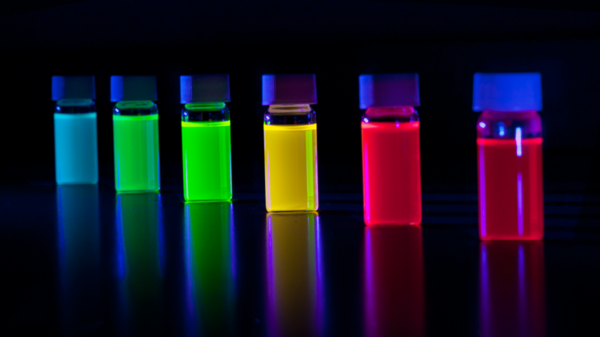Benefits of Cadmium-Free Quantum Dots (QD)
Quantum dots (QD) first entered the lexicon of materials in 1986, in a journal article focussing on spatial quantization of fabricated heterojunction systems based on gallium—arsenic (GaAs) compounds. This offered an early insight into the unique electronic subsystem of crystal heterostructures and established quantum dots as a promising material of the future. However, it also introduced one of the enduring issues of quantum dot manufacturing.

The presence of arsenic in early quantum dots foreshadowed an ongoing reliance on materials with inherent toxicity. Currently, two of the best-known quantum dot technologies are based on materials that benefit from controversial Restriction of Hazardous Substances (RoHS) exemptions. Cadmium selenide (CdSe) is the leading compound for quantum dot synthesis, despite the classification of cadmium as a carcinogenic heavy-metal. Indium phosphide (InP) is the other primary compound, yet new research suggests that indium is 10 times more toxic than cadmium.
In this blog post, Avantama briefly outlines the benefits of cadmium-free quantum dots in greater depth.
Regulatory Necessity
The exemption for cadmium in display applications was initially established due to the technological importance of cadmium-based quantum dots and the lack of a suitable alternative. Other compounds did exist, but they were neither commercially-viable nor comparable in terms of efficiency and performance. Permissible limits of cadmium concentration were set at 100 parts per million (ppm) by weight, but initially, this limit had been exempted to 1’000 ppm. This exemption by RoHS regulations is running out soon.
With the onset of new, high-performance quantum dot technologies, the exemption established for cadmium appears more fragile than ever before. In 2017, the European Commission made public their intentions to prohibit the use of cadmium in concentrations of over 100ppm from display applications by the end of 2019. The development of cadmium-free quantum dots is arguably, therefore, a matter of regulatory necessity. This comes in tandem with various cost requirements and ethical considerations. Although arguments continually suggest that the current RoHS limitation for cadmium is safe for commercial display applications, the potential toxicity of cadmium in biological environments remains an area of concern.
Cesium lead halide (CsPbX3) perovskite quantum dots are cadmium-free materials that conform to long-established RoHS regulations for lead concentration in displays. In this chemical arrangement, lead acts as the divalent cation. It is present at less than 1’000 ppm by weight of the conversion layer the quantum dots are integrated into, meeting RoHS limitations for restricted substances – other than the stricter limit of cadmium.
Low Toxicity, High Performance
Cesium lead halide perovskites were the first standout quantum dot technology to spearhead cadmium-free innovations. Now, a plethora of novel chemical arrangements has arrived with realistic, industrial-scale applicability. The initial drawback of alternative technologies was their comparatively poor performance to cadmium-based quantum dots. This was the underlying explanation for the RoHS exemption.
Avantama has developed a catalog of quantum dot materials with outstanding levels of performance. We have developed cadmium-free quantum dots with outstandingly high photoluminescent quantum yields (PLQY >99%) and the ability to reliably reproduce as much as 93% of the visible colors in nature. This challenges the hegemonic position of cadmium- and indium-based products as the only materials capable of reaching the high-performance potential of quantum dot technology.
These materials are also extremely costly and are subsequently limited to application in high-end displays. This makes them unsuitable for widening the commercial availability of quantum dot technology to low- and mid-range products, satisfying a wider consumer base. Avantama quantum dots are significantly cheaper and are poised to enter the lucrative mid-range display market currently unoccupied by quantum dot technologies.
If you would like to learn more about Avantama quantum dots, please do not hesitate to contact us directly.
Reference